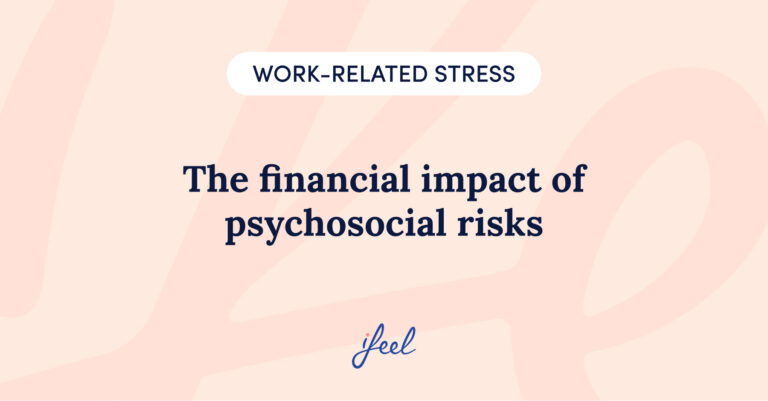There are many benefits of corporate wellness programs. They are a broad and complex topic that encompasses aspects related to companies, employees, and, of course, the relationship between them.
Benefits of corporate wellness programs
- Talent retention
- Absenteeism prevention
- Prevention of occupational hazards and compliance with laws
- Improved work environment
- Increased employee engagement

How to improve well-being in a company?
To achieve corporate well-being within companies, it is important for human resources managers to bear in mind that improving the well-being of employees, facilitating their lives, and preventing the effect of the main psychosocial risk factors to which they may be subjected, is a process that requires strategic vision and qualitative and quantitative evaluation of the effects generated.
First, we could, metaphorically, define corporate well-being in terms of what an organization “perceives” or “experiences” when functioning correctly and meeting its objectives efficiently.
However, it seems that this concept is better understood if we relate it to a significant experience of satisfaction and health by the employees who are part of that same organization.
Benefits of corporate wellness programs
Probably no one can draw up a list of disadvantages of implementing corporate wellness programs. However, it is also true that, although we value this concept positively, we are not always clear about the advantages boosting it has for the company and its employees.
It is a pity that this happens since awareness of the benefits of corporate wellness programs is essential when establishing a well-founded strategy to achieve it.
Therefore, below we will mention some points where both the company and the employees benefit as corporate wellness increases.
1. Talent retention
One of the most important damages an organization can suffer is observing how its best workers leave the team ahead of schedule because they feel their work is detrimental to their psychological well-being. Therefore, taking care of the workforce, strategically taking measures aimed at making their lives easier, is an effective measure to prevent talent drain in companies.
2. Prevents workplace absenteeism
We have just mentioned employees who leave the company for good. Before that happens, the lack of corporate wellness gradually erodes employees’ commitment, reduces the quality of their work, and, in various ways, increases the likelihood that they will not show up for work and begin to fail to fulfill their responsibilities regularly. One of the main benefits of corporate wellness programs is to help prevent absenteeism, assisting the company in saving overall costs.
3. Occupational risk prevention and compliance with laws
Any employer knows that preventing problems is technically and economically much more efficient than tackling them once they have already appeared. For this reason, investing resources in enhancing corporate well-being is a smart way to prevent the effect of the main psychosocial risk factors, not to mention an obligation currently indicated by the Labor Inspectorate.
4. Improves the work environment
Employees enjoying proper corporate well-being impacts themselves and their colleagues as they become more committed, motivated, and available. Under this logic, the more employees can witness their corporate well-being improve thanks to the strategic measures adopted by the company, the better the working atmosphere in which everyone will be involved.
5. Increased employee engagement
As we have indicated in previous points, when an employee feels at ease in their company and perceives that it takes care of their well-being, it is unlikely that they will want to leave unless they find a compelling alternative. For this reason, enhancing the corporate well-being of employees is essential to improve employee engagement and commitment to the company.
Well-being as a trend
Let’s consider corporate wellness’s occupation (and concern) as a trend. We must understand this phenomenon as the result of awareness on the part of companies about the current moment of the labor ecosystem: the old recipes for employee care have been losing validity, particularly since the beginning of the covid pandemic, making way for a new discourse on what is occupational health, what is its true importance for employees and organizations, and what are the most efficient methods to promote this so-called corporate wellness.
In this sense, it is important to remember that, as human beings, employees have always had a set of needs, expectations, or desires regarding their professional development and the relationship they want or can have with the companies they work for. As we have implied, the question is, to what extent can companies identify these needs, expectations, and desires, interpret them appropriately, and respond to them consistently?
Care for psychological well-being is currently at the center of the discourse on corporate well-being since the interpretation of companies cannot be other than the following. An employee who feels cared for and supported by their company is an employee who works better, stays longer with the company, and contributes more efficiently to its growth.
Benefits of corporate wellness programs and mental health
At ifeel, we are committed to mental health care as a fundamental element in preserving corporate well-being. After all, we understand health for what it is: “a state of complete physical, mental and social well-being, and not merely the absence of disease or infirmity”, according to the famous definition established years ago by the World Health Organization.
This implies the need for companies to be ambitious in considering their influence on people’s lives, not only when they are employees during working hours but also in the aspects of their lives outside of work.
Achieving optimal corporate well-being depends on co-responsibility between employees and companies. Hence the importance of adequately calibrating expectations: for example, to what extent can I as a company achieve employee well-being, or to what extent should I demand that my company provide me with a certain degree of well-being?
Once this has been established coherently, it is important to take action through a strategy supervised by professional psychologists specialized in well-being at work, such as those who make up the ifeel team.
How to start taking care of corporate wellness
There is no single way to design a corporate wellness strategy. People are very different, as are the jobs we do, the type of companies in which we work, and the work and non-work circumstances we live in at any given moment.
Of course, a strategic vision must be considered, starting from identifying needs with an adequate qualitative and quantitative evaluation and transforming the conclusions into concrete actions.
From there, other minimums must be considered when implementing decisions aimed at improving the corporate welfare of a company’s employees. These minimums would be, for example, to assume the complexity and specificity of individuals and to remember that corporate wellness programs must keep a balance between physical health care and psychological health care.
Ways to calculate the ROI for wellness programs
Considering how to calculate the ROI for wellness programs is an essential step in implementing any employee care strategy. After all, such an evaluation is a means for HR managers within an organization to conclude the measures that have been implemented, intending to replicate them in whole or in part or discontinue it in the future.
Suppose the wellness strategy within the company has been carried out orderly, providing moments and tools for continuous evaluation in the later stages of this process. In that case, it should not be challenging to organize and process all the information gathered from the staff members to draw conclusions and make decisions that are communicated transparently to the employees, who are the protagonists of the whole process.
When, within an organization, those responsible for managing and caring for human capital consider how to calculate the ROI wellness programs, the first thing they have to do is – as a continuation of what was proposed during the design of the program – to define the keywords of what they intend to do.

They are “success” and “corporate wellness” in this case. Therefore, before measuring the success of a corporate wellness program, we need to know what we are talking about when we talk about success and, of course, what we are talking about when we talk about wellness.
The success of a corporate wellness program is achieved as long as the objectives set out in the design phase are met, although it should be remembered that it is not limited to that issue alone. On the other hand, we can measure wellness through work environment surveys, employee motivation, or employee satisfaction with their experience as employees, bearing in mind that it is complex and highly subjective.
How can we calculate the ROI for wellness programs?
Below are five criteria used to evaluate the company’s results of a psychological wellness program. They represent several additional perspectives that should be present in the evaluation phase to make it more effective.
1. Based on objectives
As we have already mentioned, calculating the ROI for wellness programs is measured initially in terms of the goals that were set during the initial design and implementation phase of this strategy. Of course, the goals set are a function of the needs identified and express the desire of those responsible for the program to improve the quality of life of staff members and their experience as employees.
2. Based on the information gathered
In addition to being clear about the baseline from which we start and the objectives of change and improvement that we set for employees, when we consider how to measure the success of a corporate wellness program, we must take into account what we have been finding along the way during the implementation of the corporate wellness program since it is an essential complement to the starting hypotheses that were raised at the beginning.
3. Based on the efficiency of measures
When measuring the results of a corporate wellness program, it is not entirely correct to conclude that the program has been a success only by observing that the objectives set have been met. It is also necessary to follow the cost of different resources to get there and, therefore, to evaluate whether the objectives set were the right ones or whether it would have been more efficient to set other goals.
4. Qualitative and quantitative evaluation
Those responsible for implementing the corporate well-being program will ultimately determine its success based on their perceptions and criteria. However, they can also rely on the opinion of the program’s beneficiaries, which can be asked to evaluate the program’s success qualitatively and quantitatively.
This data will be a beneficial complement that, in addition to reinforcing employee involvement in the strategy, will prevent those responsible for the strategy from being satisfied with their own opinions.
5. Contextualizing the results
In short, a panoramic observation is essential to calculate the ROI for wellness programs. So, regardless of whether the results seem good or unsatisfactory to us, or what we think needs to be improved, or precisely to determine the quality of the results, it is necessary to observe what the starting point was, what results were obtained with previous strategies or what circumstances have arisen during the implementation of the program that we did not count on.

Improving emotional well-being in companies
At ifeel, we work to help companies progress by committing to employee well-being. To achieve this, our team of psychologists, experts in well-being at work, has created an emotional workplace well-being program for companies that brings relevant benefits to the entire team, including those responsible for Human Resources.
Do you have a role within your organization’s Human Resources department? We know these managers perform a job that significantly impacts the company’s results. That’s why, through our program, they can receive personalized, data-driven advice on improving the psychological well-being of their teams. Try our program now to see how it could help you.
This program offers all employees a complete mental health care service from which they can benefit differently depending on their needs. Those who wish can access an online therapy service with one of our psychologists, specialized in cases such as theirs, or interact with one of our professionals to receive emotional support in a more specific circumstance that concerns them.
In addition, in our Resources section, you can find different materials, such as podcasts, HR guides on various topics (e.g., employee experience or how to design a good HR strategy), or interviews with key HR leaders. In addition, we have a Psychosocial Risk Factors Template, which you can use to comply with the requirements of the Labor Inspectorate.
We hope this post about the benefits of corporate wellness programs has been helpful. If you want more information about our emotional well-being program for companies, simply request it, and we will contact your team as soon as possible.







